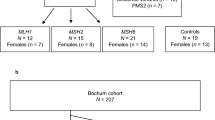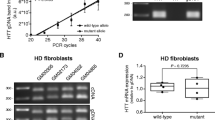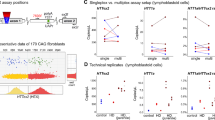Abstract
The mitochondrial DNA (mtDNA) may play an essential role in the pathogenesis of the respiratory chain complex activities in neurodegenerative disorders such as Huntington’s disease (HD). Research studies were conducted to determine the possible levels of mitochondrial defect (deletion) in HD patients and consideration of interaction between the expanded Huntingtin gene as a nuclear gene and mitochondria as a cytoplasmic organelle. To determine mtDNA damage, we investigated deletions based in four areas of mitochondrial DNA, in a group of 60 Iranian patients clinically diagnosed with HD and 70 healthy controls. A total of 41 patients out of 60 had CAG expansion (group A). About 19 patients did not show expansion but had the clinical symptoms of HD (group B). MtDNA deletions were classified into four groups according to size; 9 kb, 7.5 kb, 7 kb, and 5 kb. We found one of the four-mtDNA deletions in at least 90% of samples. Multiple deletions have also been observed in 63% of HD patients. None of the normal control (group C) showed mtDNA deletions. The sizes or locations of the deletions did not show a clear correlation with expanded CAG repeat and age in our samples. The study presented evidence that HD patients had higher frequencies of mtDNA deletions in lymphocytes in comparison to the controls. It is thus proposed that CAG repeats instability and mutant Htt are causative factor in mtDNA damage.



Similar content being viewed by others
References
Arenas J, Campos Y, Ribacoba R, Martin MA, Rubio JC, Ablanedo P, Cabello A (1998) Complex I defect in muscle from patients with Huntington’s disease. Ann Neurol 43:397–400
Bezprovanny I, Hayden MR (2004) Deranged neuronal calcium singnaling and Huntington disease. Bioch Biophy Res Comm 322:1310–1317
Cha JH (2000) Transcriptional dysregulation in Huntington’s disease. Trends Neurosci 23:387–392
Chang DTW, Rintoul GL, Pandipati S, Reynolds IJ (2006) Mutant huntingtin aggregates impair mitochondrial movement and trafficking in cortical neurons. Neurobio Dis 22:388–400
Cooper JK, Schilling G, Peters MF, Herring WJ, Sa H, Kaminsky Z, Masone J, Khan FA, Delanoy M, Borchelt DR, Dawson VL, Dawson TM, Ross CA (1998) Truncated N- terminal fragment of huntingtin with expanded glutamine repeats form nuclear and cytoplasmic aggregates in cell culture. Hum Mol Genet 7:783–790
Costa Mdo C, Teixeira-Castro A, Constante M, Magalhaes M, Magalhaes P, Cerqueira J, Vale J, Passao V, Barbosa C, Robalo C, Coutinho P, Barros J, Santos MM, Sequeiros J, Maciel P (2006) Exclusion of mutations in the PRNP, JPH3, TBP, ATN1, CREBBP, POU3F2 and FTL genes as a cause of disease in Portuguese patients with a Huntington-like phenotype. J Hum Genet 51:645–651
Fesahat F, Houshmand M, Panahi MSS, Gharagozli K, Mirzajani F (2007) Do haplogroups h and u act to increase the penetrance of Alzheimer’s disease? Cell Mol Neurobiol 27:329–334
Hazeki N, Nakamura K, Goto J, Kanazawa I (1999) Rapid aggregate formation of the huntingtin N-terminal fragment carrying an expanded polyglutamine tract. Biochem Biophys Res Commun 256:361–366
Hirano M, Marti R, Ferreiro-Barros C, Vila MR, Tadesse S, Nishigaki Y, Nishino I, Vu TH (2001) Defects of intergenomic communication: autosomal disorders that cause multiple deletions and depletion of mitochondrial DNA. Semin Cell Dev Biol 12:417–427
Hormozian F, Houshmand M, Sanati MH, Ghiasvand M, Banoei MM (2004) Molecular analysis of (CAG)n repeat causing Huntington’s disease in 34 Iranian families. Ind J Hum Genet 10:53–57
Horton TM, Graham BH, Corral-Debrinski M, Shoffner JM, Kaufman AE, Beal MF, Wallace DC (1995) Marked increase in mitochondrial DNA deletion levels in the cerebral cortex of Huntington’s disease patients. Neurology 45:1879–1883
Houshmand M, Panahi MSS, Fesahat F, Gharagozli K (2007) Lack of association between mitochondrial A4336G /haplogroup and Parkinson’s disease. Chinese J Clin Med 2:259–265
Houshmand M, Panahi MSS, Nafisi S, Soltanzadeh A, Alkandari FM (2006) Identification and sizing of GAA trinucleotide repeat expansion, investigation for D-loop variations and mitochondrial deletions in Iranian patients with Friedreich’s ataxia. Mitochondrion 6:82–88
Krausz C, Guarducci E, Becherini L, Degl’Innocenti S, Gerace L, Balercia G, Forti G (2004) The clinical significance of the POLG gene polymorphism in male infertility. J Clin Endocrinol Metab 89:4292–4297
Kuemmerle S, Gutekunst CA, Klein AM, Li XJ, Li SH, Beal MF, Hersch SM, Ferrante RJ (1999) Huntington aggregates may not predict neuronal death in Huntington’s disease. Ann Neurol 46:842–849
Manfredi G, Xu Z (2005) Mitochondrial dysfunction and its role in motor neuron degeneration in ALS. Mitochondrion 5:77–87
Matrin JB (1999) Molecular basis of neurodegenerative disorders. New Eng J Med 340:1970–1980
Mawrin C, Kirches E, Krause G, Schneider-Stock R, Bogerts B, Vorwerk CK, Dietzmann K (2004) Region-specific analysis of mitochondrial DNA deletions in neurodegenerative disorders in humans. Neurosci Lett 357:111–114
Meade CA, Deng YP, Fusco FR, Del Mar N, Hersch S, Goldowitz D, Reiner A (2002) Cellular localization and development of neuronal intranuclear inclusions in striatal and cortical neurons in R6/2 transgenic mice. J Comp Neurol 449:241–269
Moslemi AR, Melberg A, Holme E, Oldfors A (1996) Clonal expansion of mitochondrial DNA with multiple deletions in autosomal dominant progressive external ophthalmoplegia. Ann Neurol 40:707–713
Sawa A, Wiegand GW, Cooper J, Margolis RL, Sharp AH, Lawler JF Jr, Greenamyre JT, Snyder SH, Ross CA (1999) Increased apoptosis of Huntington disease lymphoblasts associated with repeat length-dependent mitochondrial depolarization. Nat Med 5:1194–1198
Schapira AH (2002) The “new” mitochondrial disorders. J Neurol Neurosurg Psychiatry 72:144–149
Schapira AHV (1999) Mitochondrial involvement in Parkinson’s disease, Huntington’s disease, hereditary spastic paraplegia and Friedreich’s ataxia. Biochim Biophys Acta 1410:159–170
Schffer IE (2000) A century mitochondrial research: achievements and perspectives. Mitochondrion 1(1):3–31
Schon EA, Manfredi G (2003) Neuronal degeneration and mitochondrial dysfunction. J Clin Invest 111:303–312
Squitieri F, Cannella M, Sgarbi G, Maglione V, Falleni A, Lenzi P, Baracca A, Cislaghi G, Saft C, Ragona G, Russo MA, Thompson LM, Solaini G, Fornai F (2006) Severe ultrastructural mitochondrial changes in lymphoblasts homozygous for Huntington disease mutation. Mech Aging Dev 127:217–220
Stevanin G, Fujigasaki H, Lebre AS, Camuzat A, Jeannequin C, Dode C, Takahashi J, San C, Bellance R, Brice A, Durr A (2003) Huntington’s disease-like phenotype due to trinucleotide repeat expansions in the TBP and JPH3 genes. Brain 126:1599–1603
Taanman JW, Schapira AH (2005) Analysis of the trinucleotide CAG repeat from the DNA polymerase gamma gene (POLG) in patients with Parkinson’s disease. Neurosci Lett 376:56–59
Tabrizi SJ, Schapira AH (1999) Secondary abnormalities of mitochondrial DNA associated with neurodegeneration. Biochem Soc Symp 66:99–110
Truant R (2003) Nucleocytoplasmic transport of huntingtin and Huntington’s disease. Clin Neurosci Res 3:157–164
Valabrese V, Lodi R, Tonon C, D’agata V, Sapienza M, Scapagnini G, Mangiameli A, Pennisi G, Giuffrida Stella AM, Butterfield DA (2005) Oxidative stress, mitochondrial dysfunction and cellular stress response in Friedreich’s ataxia. J Neuro Sci 233:145–162
Van Roon-Mom WMC, Reid SJ, Faull RLM, Snell RG (2005) TATA binding protein in neurodegenerative disease. Neurosci 133:863–872
Wallace DC (1994) Mitochondrial DNA sequence variation in human evolution and disease. Proc Nat Acad Sci USA 91:8739–8746
Wallace DC (1999) Mitochondrial disease in man and mouse. Science 283:483–488
Wallace DC, Shoffner JM, Trounce I, Brown MD, Ballinger SW, Corral-Debrinski M, Horton T, Jun AS, Lott MT (1995) Mitochondrial DNA mutations in human degenerative diseases and aging. Biochim Biophys Acta 1271(1):141–151
Wanagat J, Cao Z, Pathare P, Aiken JM (2001) Mitochondrial DNA deletion mutations colocalize with segmental electron transport system abnormalities, muscle fiber atrophy, fiber splitting and oxidative damage in sarcopenis. FASEB 15:323–332
Wang ZC, Wang XM, Jiao BH, Jin YX, Miao MY, Zhu KJ (2003) Detection of mitochondrial DNA deletion by a modified PCR method in a Co radiation- exposed patient. IUBMB Life 55:133–137
Acknowledgments
We would like to thank all patients and their families whose collaboration and understanding allowed us to do this work, as well as their permission to publish it.
Author information
Authors and Affiliations
Corresponding author
Additional information
Mohammad Mehdi Banoei and Mehdi Shafa Shariat Panahi equally contributed to this work.
Rights and permissions
About this article
Cite this article
Banoei, M.M., Houshmand, M., Panahi, M.S.S. et al. Huntington’s Disease and Mitochondrial DNA Deletions: Event or Regular Mechanism for Mutant Huntingtin Protein and CAG Repeats Expansion?!. Cell Mol Neurobiol 27, 867–875 (2007). https://doi.org/10.1007/s10571-007-9206-5
Received:
Accepted:
Published:
Issue Date:
DOI: https://doi.org/10.1007/s10571-007-9206-5




